
J. W. Walker & Sons Ltd is a British firm of organ builders established in 1828 by Joseph William Walker in London. Walker organs were popular additions to churches during the Gothic Revival era of church building and restoration in Victorian Britain, and instruments built by Walker are found in many churches around the UK and in other countries. The firm continues to build organs today.

St George in the Meadows is a parish church in the Church of England in The Meadows, Nottingham, England.

Charles Lloyd was a pipe organ builder based in Nottingham who flourished between 1859 and 1908.

James Jepson Binns was a pipe organ builder based in Leeds, West Yorkshire, England.
The church of St. John the Baptist, Leenside, Nottingham was opened in 1844 as a parish church in the Church of England. It was destroyed in 1941.

The Nottingham Mechanics' Institution was founded in 1837 in Nottingham to improve the knowledge of working men with classes and lectures, the provision of libraries, performances of music, drama and readings, and through social contact with a good cross-section of the better educated members of the community with the aim TO PROMOTE THE BENEFIT OF THE INHABITANTS OF THE CITY OF NOTTINGHAM AND THE NEIGHBOURHOOD AREAS THEREOF BY THE ADVANCEMENT OF EDUCATION AND THE PROVISION, IN THE INTERESTS OF SOCIAL WELFARE AND WITH THE OBJECT OF IMPROVING CONDITIONS OF LIFE, OF FACILITIES FOR RECREATION AND OTHER LEISURE-TIME OCCUPATION They are an educational charity still based in the City
.

Church of Christ the Cornerstone is an ecumenical church in Milton Keynes, Buckinghamshire. It was completed in 1991 and has the Church of England, the Baptist Union, the Methodist Church, the Roman Catholic Church and the United Reformed Church working together to share the space. It is situated in Central Milton Keynes on Saxon Gate, between Midsummer and Silbury boulevards, with the Fred Roche Memorial Gardens behind it. It was the first ecumenical metro centre church in the United Kingdom.
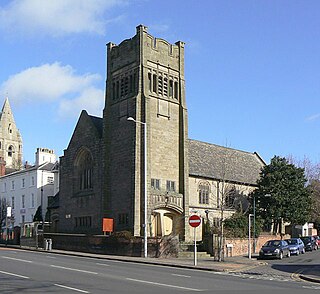
St Columba's Church, Nottingham was an English Presbyterian church in Nottingham, England, built in 1898 and located at the Mansfield Road/Villa Road intersection. It was founded in 1896 as a daughter church of St Andrew's Presbyterian Church, also in Nottingham. The new buildings by Brewill and Baily were started in 1896 and complete by 1900.
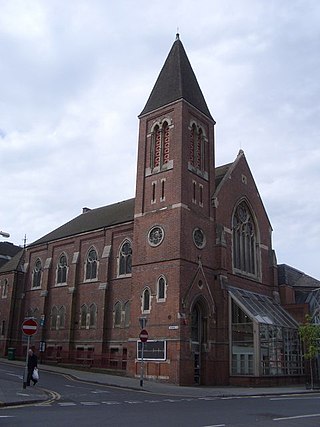
Parliament Street Methodist Church is a Methodist church on Parliament Street in Nottingham.

Stoney Street Baptist Chapel is a former Baptist Church on Plumptre Place Road in Nottingham. It is a Grade II listed building. Later it served as St. Mary's Schools, and then as a commercial premises.
Halixfax Place Wesleyan Chapel was a former Methodist Chapel in Nottingham from 1798 to 1930. The building dating from 1847 had the highest ceiling of any Wesleyan Methodist church in England. The building was finally demolished in 1966.
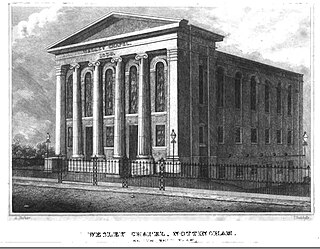
Broad Street Wesleyan Chapel was a former Methodist chapel in Nottingham from 1839 to 1954. The building is now occupied by the Broadway Cinema.
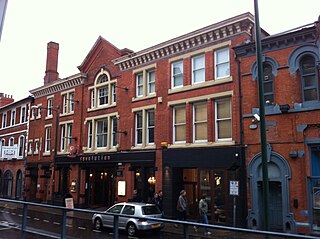
Broad Street Baptist Church was a former Baptist Church in Nottingham from 1818 to 1901. The building is now occupied by the Revolution bar.
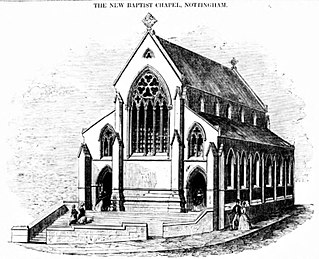
Derby Road Particular Baptist Church was a former Baptist Church in Nottingham from 1850 to 1967.

St John the Evangelist's Church was the first purpose-built Roman Catholic Church to be built in Nottingham since the English Reformation. Now offices, it is a Grade II listed building.

Friary United Reformed church was a church on Musters Road in West Bridgford, Nottingham, built between 1898 and 1901. It was a Grade II listed building. It closed in June 2022.
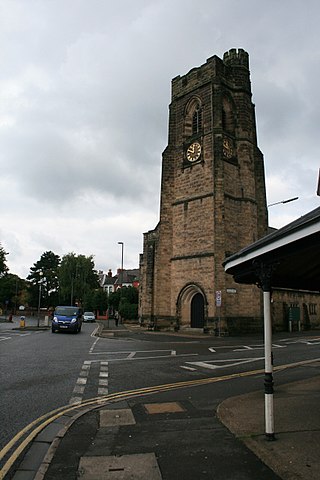
Christ Church Methodist Church is a Grade II listed English church in Long Eaton, Derbyshire, England.
Samuel Groves was a British organ builder based in London.

Belper Baptist Church is a Baptist Chapel on Bridge Street in Belper, Derbyshire, England.

Cannon Street Baptist Church, Accrington is a Grade II listed former Baptist church in Accrington, Lancashire.


















